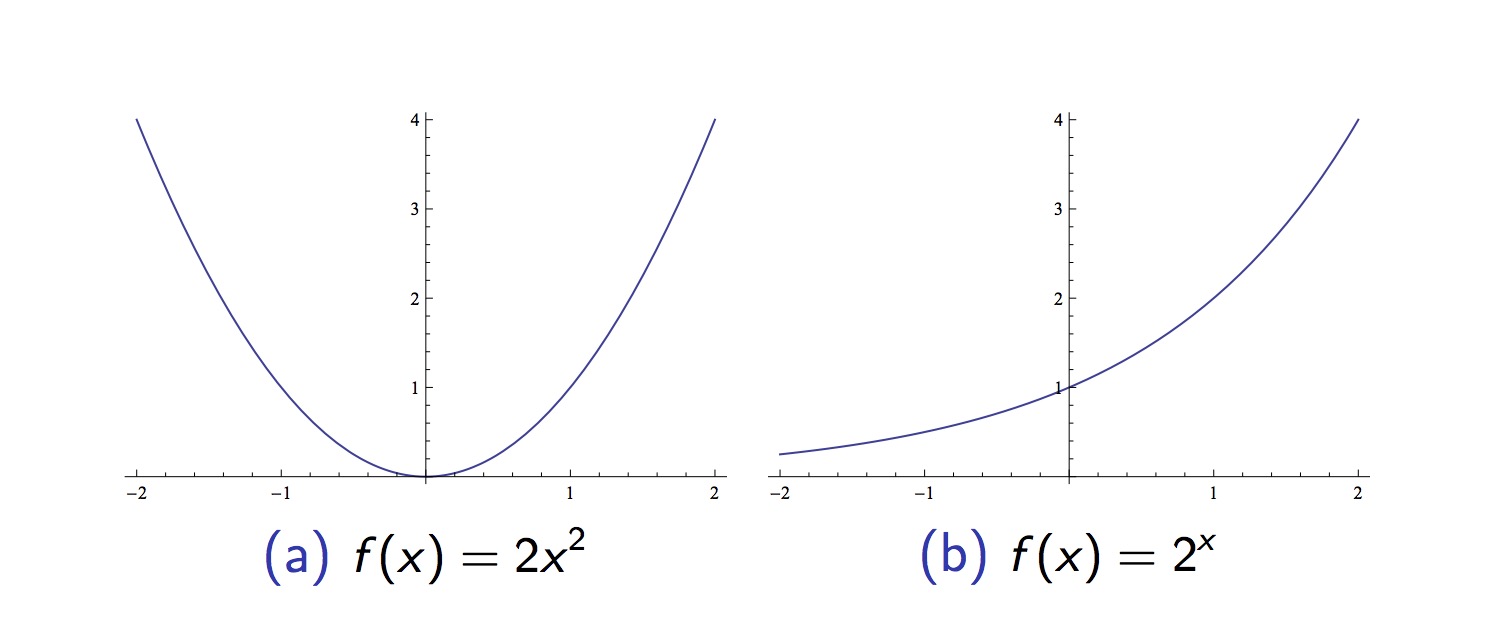MAT9004复习总结(2)
Concave Function
A function is concave if, for any two points in its plot, the straight line between both points is entirely below (or touching) the plot of the function. 
Convex Function
A function is convex if, for any two points in its plot, the straight line between both points is entirely above (or touching) the plot of the function. 
Bijection
A function \(f : X → Y\) is called :
injective (or one-to-one) if for all distinct \(x1, x2 ∈ X\) and \(f(x1) != f(x2)\)
surjective if \(Y = f (X)\), that is if for every \(y ∈ Y\) there is an \(x ∈ X\) with \(f (x) = y\)
bijective if it is both injective and surjective
Log-Log Plot
The log-log plot of a data set \((x_1, y_1), . . . ,(x_n, y_n)\) is the plot of the data \((ln(x_1), ln(y_1)), . . .(ln(x_n), ln(y_n))\)
If \((x_1, y_1), . . . ,(x_n, y_n)\) are points of the graph of a power-law function, then \((ln(x_1), ln(y_1)), . . . ,(ln(x_n), ln(y_n))\) are points of the graph of a linear function with :
slope equal to the exponent of the power-law function
y-intercept equal to ln(b), if the original function was \(f (x) = bx^{−a}\)
Derivertive Rules
If \(f (x) = f_1(f_2(x))\) then \(f'(x) = f'_2 (x)f'_1(f'_2(x)\)
If \(g(x) = g_1(x)g_2(x)\) then \(g'(x) = g'_1(x)g_2(x) + g_1(x)g'_2 (x)\)
If \(h_1(x) = x^b\) then \(h'_1 (x) = bx^{b−1}\)
If \(h_2(x) = a^x\) then \(h'_2 (x) = ln(a)a^x\)
If \(h3(x) = log_a(x)\) then \(h'_3(x) = {1 \over ln(a)x}\)
Increasing/Decreasing of Function
For an arbitrary function f :
On any interval where \(f'(x)\) is positive, \(f\) increases
On any interval where \(f'(x)\) is negative, \(f\) decreases
Local Maxima/Minima
A local maximum of f is a stationary point where f 0 changes from positive to negative (as x moves left to right)
A local minimum of f is a stationary point where f 0 changes from negative to positive
Sufficient Conditions for Judging
If a is a stationary point of \(f\) and \(f''(a)\) exists then :
\(f\) has a local minimum at \(x = a\) if \(f''(a) > 0\)
\(f\) has a local maximum at \(x = a\) if \(f''(a) < 0\)
\(f''(a) = 0\) gives no conclusion
Antiderivatives
A function \(F\) is an antiderivative of f if \(F' = f\)
Some basic antiderivatives
If \(f (x) = x^a\) where \(a \neq −1\); \(F(x) = {1\over a+1} x^{a+1}\)
If \(f (x) = x^{−1}\) ; \(F(x) = ln(x)\)
If \(f (x) = e^{ax}\) where \(a \neq 0\); \(F(x) = {1\over a} e^{ax}\)
Calculus
If \(F\) is an antiderivative of \(f\) then : \[\int_a^b f(x) dx = F(b) - F(a)\]
And \(F(x)+c\) is the indefinite integral of \(f\)
Linearity
If \(f\) and \(g\) are functions then : \[\int_a^b f(x)+g(x) dx = \int_a^b f(x)dx + \int_a^b g(x)dx\]
If \(f\) is a function and \(c\) is a constant then : \[\int_a^b cf(x)dx = c\int_a^b f(x) dx\]
Another Property
If \(a,b,c\) are real numbers with \(a<b<c\) then : \[\int_a^c f(x) dx = \int_a^b f(x) dx + \int_b^c f(x) dx\]